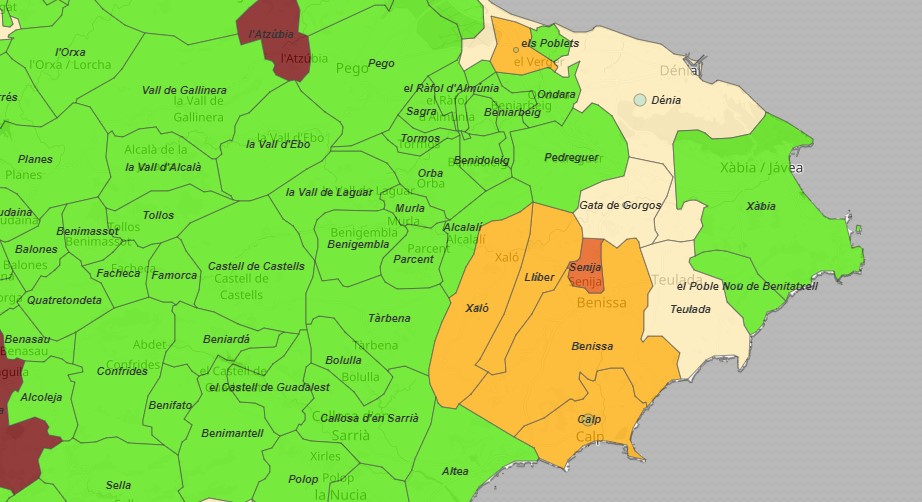VIRUS UPDATE: Xàbia infection rate drops to 3.57
The Ministry of Health reports 126 new positive cases in the Marina Alta in a “adjustment” of the figures.

Tuesday 18th May 2021 – Compiled by MIKE SMITH
One new positive case has been detected in Xàbia in the last 14 days, according to the latest update from the regional health ministry. However, a massive “readjustment” of the data means that the number of positive cases recorded in the town since the beginning of the pandemic has jumped five at 1,463.
Despite this adjustment, the municipality’s 14-day IA rate, a measure of the speed at which the virus moves through the population, has dropped to 3.57 cases per 100,000 inhabitants, a figure not seen for many months and one that continues to place the town in the ‘New Normal’ category. In addition, there have been no new deaths since late March and the number for Xàbia remains at 12.
In the Marina Alta region, there have been 10 new positive cases detected in the past 14 days, although the readjustment has meant that the total number of positive cases recorded in the Dénia Health Authority – which covers the Marina Alta – has jumped to 10,504. However, the 14-day IA rate has risen only slightly to 35.75 cases per 100,000 inhabitants and the region remains in the ‘Low Risk’ category. There has been 1 new death – in Teulada – and the region’s toll climbs to 203.
The readjustment means that the individual municipal figures don’t tell the true story (Dénia has jumped by 52 new positives but, in reality, the town has detected 16 in the past 14 days). However, the 14-day IA rates have not been affected. Adsubia has climbed into the ‘Extreme Risk’ category with 327.33, almost double the national average, whilst Senija remains in the ‘High Risk’ level with 171.53. However, both municipalities have small populations which means a single positive case is a major cause for concern with regards to spread.
Xaló, Lliber, Benissa, El Vergel and Calp are currently in the ‘Medium Risk’ category, whilst Gata de Gorgos, Teulada, Dénia and Poble Nou de Benitatxell find themselves in the ‘Low Risk’ level. The rest of the Marina Alta is colour green for the ‘New Normal’ with 19 municipalities have recorded no new cases in the last 14 days.
Spain
Spain’s 14-day IA rate is 151.82 cases per 100,000 inhabitants, placing the country in the ‘High Risk’ category but less than 2 points from dropping into the “Medium Risk” level. The rate has dropped more than 32% in the past two weeks, along with the Positivity Rate, the measure of how many coronavirus tests return positive, which has dropped to 5.38%, its lowest level since the end of March; a value of 5% or less would be indicative that transmission of the virus was under control.
Across the autonomous regions, the País Vasco still leads the way with a 14-day IA rate of 295.34, placing it in the highest ‘Extreme Risk’ category along with one others, Melilla (253.80) whilst Ceuta (17.18) becomes the first autonomous area to drop into the ‘New Normal’ category. The Comunidad Valenciana (29.48) remains at the ‘Low Risk’ level, dropping below the 30 mark for the first time for many months.
Infection spread has continued dropped in the majority of Spain’s autonomous regions and enclaves; Murcia has defied the trend, it’s 14-day IA rate having risen very slightly since the end of the last week, whilst Galicia also experienced saw a small rise in infection rate.
The newspaper El País has reported that Spanish prime minister Pedro Sánchez has announced a mass vaccination of the 40-49 age group in June when one in five of the 50-59 age group will have already received at least one dose.
Speaking to El Pais, Antoni Trill, head of the Preventative Medicine department at the Barcelona Clinic Hospital said that COVID-19 will “not disappear so fast” adding that he doubts that it will ever disappear completely. “We will move toward normality, but there will still be infections. Instead of group immunity, we are talking in this case about a functional control of the pandemic. We are not going to be able to say goodbye to masks so quickly.”
Quique Bassat, epidemiologist and researcher at the ISGlobal institute in Barcelona, added that the 70% group immunity target recently announced by prime minister Pedro Sanchez will not be enough to stop the virus from spreading. “A year ago, the estimate for the SARS-CoV-2 R number (how many new cases on average will be caused by one infected person) was 2 to 3, and that is where the objective of 70% came from. But now there are more contagious variants and the R number could be between 3 and 5. A more transmissible virus forces you to vaccinate more people. Perhaps 80% to 90% will be needed now.” To put that in context, the measles virus has an R number of more than 12, which means that more than 95% of the population needs to be vaccinated to achieve group immunity.
Vaccination (17.05.21)
Spain has administered 22,313,088 doses of vaccine, which is 93.4% of those which it has already received. A total of 7,213,716 people have completed the recommended course, which is 18.0% of the total of the population which is to be vaccinated (40,129,822).
According to the latest data provided by the health authorities, 92.0% of people aged 60 and over in Spain have received at least one dose, with 47.7% having completed the recommended course.
The Comunidad Valenciana has administered 2,217,729 doses of vaccine, which is 92.5% of the total which it has received. A total of 709,438 people have completed the recommended course, which 16.8% of the population which is to be vaccinated (4,289,305).
According to the latest data provided by the health authorities, 92.9% of people aged 60 and over in the Comunidad Valenciana have received at least one dose, with 46.0% having completed the recommended course.
LINKS
- Actualización nº 376. Enfermedad por el coronavirus (COVID-19). 17.05.2021
- GIV COVID-19 Gestión integral de la vacunación COVID-19
- COVID-19 C. Valenciana: Monitoratge de la situació




